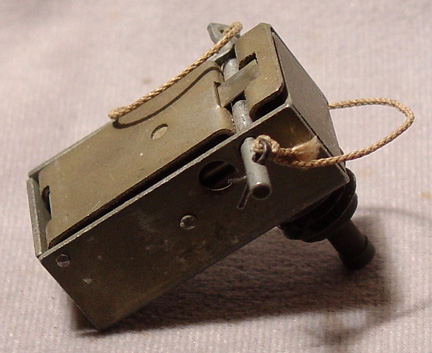Home / Shop
Firing Device, Release, M5


- Description
In June of 1943, Captain Terbert of the Engineer Board gave the A. C. Gilbert Co. a model of a release device and asked them to incorporate some changes to the model and make samples. Once the samples were produced and approved a number were made for training. During training it was found that further changes and improvements were required. Several revised models were produced until one finally satisfied all the requirements of the Engineer Board. The final model was standardized as the “Firing Device, Release, M5”
The device is made of sheet steel and is press formed into an open topped rectangular box. On the bottom of the box is a hole threaded to accept the base coupler. The release plate is hinged on the top on the opposite end to the hole in the bottom. The release plate is bent to form a hinge at one end and near the other end is bent to form a dip for the safety pin. A piece of spring steel is riveted onto the release plate so that it will put pressure on the safety pin to hold it in place. A spring loaded striker is hinged in the middle of the box so that when the striker rotates the striker point will strike the percussion cap in the base coupler. There are holes in the side of the box, one set for the safety pin that line up with the dip in the release plate, the other larger set allow a pin or nail to be inserted to block the travel of the striker. The safety pin has two grooves turned into it that will slightly engage the sides of the mechanism and make removal more difficult if the release plate is not fully down. A small cotter pin through one end of the safety pin prevents accidental removal.
A minimum weight of 5 lbs is required to hold the release plate down when laid. When the weight is removed the striker spring reasserts itself and causes the striker to rotate. The rotating striker pushes up on the release plate until it is pushed out of the way and the striker is free to completely rotate and hit the percussion cap in the base coupler. The percussion cap will cause the detonator attached to the base coupler to fire.